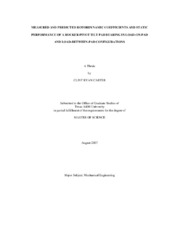| dc.description.abstract | This thesis presents the static and dynamic performance data for a 5 pad tilting pad bearing in both the load-on-pad (LOP) and the load-between-pad (LBP) configurations over a variety of different loads and speeds. The bearing tested was an Orion Advantage with direct lubrication exhibiting these specifications: 5 pads, .282 preload, 60% offset, 57.87° pad arc angle, 101.587 mm (3.9995 in) rotor diameter, .1575 mm (.0062 in) diametrical clearance, 60.325 mm (2.375 in) pad length. Dynamic tests were performed over a range of frequencies to observe any frequency effects on the dynamic stfffnesses. It was found that under most test conditions the direct real part of the dynamic stiffnesses could be approximated as quadratic functions of the excitation frequency. This frequency dependency is caused by pad inertia, pad flexibility, and fluid inertia. The observed frequency dependency can be accounted for with the addition of an added mass matrix to the conventional [K][C] matrix model to produce a frequency independent [K][C][M] model. This method eliminates the often debated question over whether a stability analysis should be performed at the running speed or at the first natural frequency. Substantially large added mass terms in the loaded direction were found that approached 60 kg. Some conditions for the LBP bearing exhibited unloaded direct mass coefficients that were at or near zero, which would lead to a frequency dependent [K][C] model to be used instead. The whirl frequency ratio was found to be zero at all test conditions. Static data were also recorded which included pad temperatures, attitude angle, eccentricity, static stiffness and power loss. Some cross coupling in the form of deviation from the loaded axis was evident from the locus plots; however, the cross coupled stiffness coefficients were found to be very small relative to the direct stiffness coefficients. Both static and dynamic experimental results were compared to theoretical predictions via a bulk flow analysis. Most parameters were modeled well including the static eccentricity e dynamic direct stiffness coefficients Kxx and Kyy, which were slightly over predicted. However, the direct damping coefficients Cxx and Cyy were significantly over predicted. | en |


